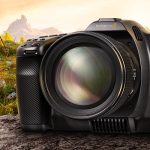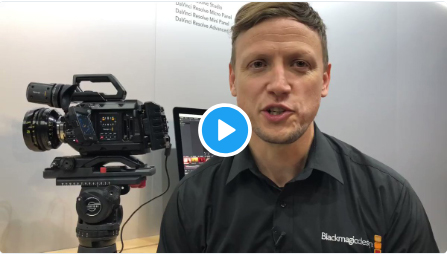After six months playing around with the Blackmagic Pocket Cinema Camera 4K, Yusuk Thakur tells Garima Rawat his first experiences of using the much-anticipated Camera. Read on to find out if it made the cut… Dubai-based filmmaker Yusuf Thakur, who has been filming wildlife across the world since 2003, was thrilled to be the […]

After six months playing around with the Blackmagic Pocket Cinema Camera 4K, Yusuk Thakur tells Garima Rawat his first experiences of using the much-anticipated Camera. Read on to find out if it made the cut…
Dubai-based filmmaker Yusuf Thakur, who has been filming wildlife across the world since 2003, was thrilled to be the first in the Middle East to receive the Blackmagic Pocket Cinema Camera. From his six months using the camera, Thakur has many lessons to offer on getting the best value and utility from it. He shares his journey of hits and misses, and what really makes it tick.
Blackmagic recently released version 2 of the camera with the new Blackmagic Camera 6.2 update, which added support for Blackmagic RAW (BRAW). BRAW allows filmmakers to record longer duration of footage and change parameters such as exposure and saturation. BRAW offers a record time of more than two hours of 4K DCI footage on a single 500GB SSD card.
Version 2 differs from its predecessor only in the recording format. The earlier variant sported Cinema DNG, while the new version offers BRAW. The Cinema DNG format was not very popular among users, which is why Blackmagic needed to bring out the BRAW update.
Thakur gives us his take.
He says: The original camera released with Cinema DNG as its RAW recording format. Its container-based and cumbersome, unlike a single video. The good thing about it is that in a still frame, the latitude to grade is so vast, and you can use anything from Photoshop to a high-end grading software.
I have shot extensively now on BRAW and I am equally impressed with what this can do. BRAW offers recording in RAW, and in post-production, there is so much scope to grade and work with the footage. BRAW is user-friendly and allows ample data to be recorded, which can be stored on internal and external drives. Cinema DNG is not an easy format for beginners and you need a lot of practice and patience to work with it.

All good things come to those who wait, and the Blackmagic Pocket Cinema Camera is just that for photographers and filmmakers, says Thakur.
You get a super bright five-inch screen and two in-built microphones, while the external buttons have been designed to offer quick and seamless access to all functions. The image quality and BRAW recording features let you shoot images that rival professional digital film cameras costing tens of thousands more. Blackmagic Pocket Cinema Camera 4K version 2 is no longer a pocket camera, but it is the only camera in the form factor that does internal 4K RAW recording.
As a filmmaker, this is really important to me. This is what sets the Blackmagic camera apart from everything out there in the market. Its no longer pocket; it is in a DSLR form factor and is unique in its design.
The Blackmagic Pocket Cinema Camera ticks many boxes for filmmakers, and scores highest in its ability to record RAW internally, as well as its affordability and portability.
Wildlife filming is already quite challenging for filmmakers and weight is an additional concern. Earlier, I filmed with cameras that alone weighed around 15kg. This camera has made it possible for me to be truly mobile. Now my whole kit is no more than 20kg, which includes a tripod, batteries, a small jib arm, a slider and so on, says Thakur.
A camera that weighs less is also easier to carry on international flights, especially with the growing limitations on weight by flight carriers. This camera offers me more space to carry other essentials. The camera body is quite compact and lightweight, which makes it favourable to travel with.
“The image quality and BRAW recording features let you shoot images that rival professional digital film cameras costing tens of thousands more,” Yusuf Thakur, filmmaker.

At $1,400, this camera is a steal because it can record RAW and comes in a compact form factor with an in-built five-inch viewfinder. The camera works very well with my style of working, with the modularity of the filming system. I have invested in a couple of these cameras, and thanks to its portable design and affordable price, I can leave it behind in a country if I am going to return for a shoot and cant carry it with me. Similarly, for dangerous shoots, this is my preferred camera as the risk is relatively low.
The Blackmagic Pocket Cinema Camera sports a 4/3 size sensor with 13 stops of dynamic range. Its dual native ISO feature offers filmmakers good performance in low-light conditions. The external controls offer convenient access to basic shooting functionalities. The most dramatic aspect is the five-inch monitor, which differentiates it from others in its league. The large screen offers filmmakers a good chance to frame shots and focus on the right object. The camera offers recording on standard SD/UHS-II or CFast 2.0 cards in Blackmagic RAW (BRAW) and ProRes, at up to 120 frames per second.
Calling it a complete unit for filming, Thakur explains: The Blackmagic Pocket Cinema Camera has an MFT lens mount, built-in microphones, mini XLR input, full-sized HDMI, 3D LUT support, Bluetooth, USB-C expansion port and other features that make it a complete unit. The camera lets you check framing and focus, capture audio and record files without having to carry around extra monitors, microphones, recorders and cables. You dont have to use add-ons and build this camera to shoot. You can just power it on and start recording.
This camera is apt for documentary-style shoots, as the filmmaker doesnt need to carry the add-ons separately. The scratch mic offered on the camera captures ambient sound. The only problem is that it captures all the sound and you will need a separate mic if you need to capture just one specific sound.
Battery performance is another aspect that has critics complaining. The camera allegedly drains out faster and doesnt offer a lot of recording time. However, Thakur has devised his own way of using batteries that last longer. He shares his hack.
It is quite evident that a five-inch monitor and RAW recording capabilities put a lot of strain on the camera battery. The solution lies in exploring ways to power the camera. Blackmagic offers several options to power this camera. You can power it through a USB cable. The only catch is that you cant simultaneously record on an external USB SSD. The other option is to use a V-mount battery. The battery I use has a USB and D-Tap output, and I can power up and charge the camera plus use an additional monitor. The 130W battery helps run the camera for around four hours continuously and can last for a full day of shooting. The same battery runs the RED for under one-and-a-half hours.

Many first-time filmmakers buy this camera and complain about battery life. While this camera may deliver on some aspects, if they shoot RAW, they will need to work in post-production to achieve the desired result. Those looking for instant options may have to look elsewhere, as this may not be the ideal choice. For those who have tinkered with a variety of cameras and can benchmark the performance of this camera, I would not hesitate to say that this camera turns Red to Black!
I have used cameras from Red and they are in their own bracket. Both companies have proprietary codecs. BRAW is easier to use in terms of playback and editing. The biggest differentiator for Blackmagic here is that you dont need any additional accessories to shoot. Take the camera and the lens, and you are good to go.
A camera recording in form factor at the current price makes this camera a real champion in the industry. The lightweight body, coupled with its capabilities, makes it a worthy addition to our product portfolio.













































































